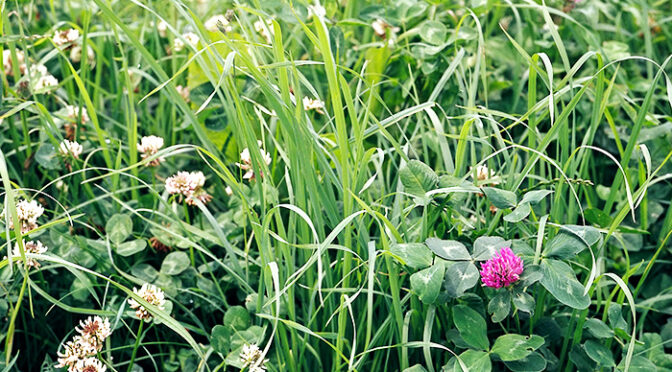By Sergei Schaub
Background
Grasslands cover a large portion of the global land area and are essential for global food security and the agricultural economy. Grasslands provide many ecosystem services in addition to forage production, such as biodiversity, pollination, carbon sequestration, and outdoor recreation. Changes in agricultural production, biodiversity loss, and climate change (and with it, for example, increased droughts) are putting increasing pressure on grasslands and grassland-based production. This increasing pressure requires farmers to make adjustments.
Farmers have several instruments at their disposal to adapt their grasslands, including the choice of (plant) species diversity. Species diversity can increase yields and grassland stability, as well as species diversity can reduce the adverse effects of weather extremes (e.g., droughts). A key challenge is to quantify these species diversity benefits for farmers economically. These realities gave rise to the central question of my dissertation: ‘What is the value of species diversity for farmers in grasslands?’
What evidence is useful for policymaking?
In my thesis1, I showed that species diversity can increase yields while it did overall not negatively affect forage quality, both in intensively managed grasslands and managed semi-natural grasslands. Thus, species diversity can increase revenues from milk production. Additionally, I found that species diversity can reduce production risk in intensively managed grasslands. These benefits of species diversity were also present under climate change conditions, i.e., increasing drought probability. Therefore, my thesis results show that species diversity can be an economically relevant production factor and that the increasing species diversity in grasslands can contribute to sustainable intensification of grassland-based production.
Additionally, other studies indicated that species diversity can also support other important ecosystem services and functions (e.g., biodiversity, pollination, and cultural ecosystem services), which I did not consider in my thesis. One key challenge to benefit from species diversity (and especially for semi-natural grasslands) will be to develop management systems that allow maintaining plant diversity over time in more intensively managed grasslands.
Throughout my PhD, I (and my co-authors) published blog articles and press releases2,3,4,5,6,7 to make my PhD project, its results, and my other projects8,9,10,11 available to the general public and attract attention from policymakers and journalists. During my PhD, the work contributed to an Arbeitsgemeinschaft zur Förderung des Futterbaus (AGFF) infosheet, and I worked closely in collaboration with Agroscope.
References
1 Sergei Schaub (2020). ‘Economic Perspective on Grasslands, Biodiversity and Weather Extremes’. ETH Zürich, https://doi.org/10.3929/ethz-b-000447273 (limited access)
2 Schaub, S., & Finger, R. (2017). Ist Diversität im Grasland ökonomisch wertvoll? Agrarpolitik-Blog. https://agrarpolitik-blog.com/2017/12/11/ist-diversitaet-im-grasland-oekonomisch-wertvoll/
3 Schaub, S. (2018). The value of species diversity in grassland meets Vancouver, Canada. Food System Stories. http://www.foodsystemstories.org/blog/2018/11/2/the-value-of-species-diversity-in-grassland-meets-vancouver-canada
4 Schaub, S., Buchmann, N., Lüscher, A., & Finger, R. (2020). Der ökonomische Mehrwert von Diversität im intensiven Grasland. Agrarpolitik-Blog. https://agrarpolitik-blog.com/2020/01/15/der-oekonomische-mehrwert-von-diversitaet-im-intensiven-grasland/
5 Schaub, S., & Finger, R. (2020). Wie wirkt sich Dürre auf Futterpreise aus?. Agrarpolitik-Blog. https://agrarpolitik-blog.com/2020/01/28/wie-wirkt-sich-duerre-auf-futterpreise-aus/
6 ETH Zurich News – https://ethz.ch/en/news-and-events/eth-news/news/2020/02/biodiversity-yields-financial-returns.html
7 Schaub, S., Huber, R., & Finger, R. (2020). Google Trends für die Agrarpolitik – Illustriert am Beispiel von Pestiziden. Agrarpolitik-Blog. https://agrarpolitik-blog.com/2020/08/20/google-trends-fuer-die-agrarpolitik-illustriert-am-beispiel-von-pestiziden/
8 Schaub, S., Buchmann, N., Lüscher, A., & Finger, R. (2020). Economic benefits from plant species diversity in intensively managed grasslands. Ecological Economics, 168, 106488. https://doi.org/10.1016/j.ecolecon.2019.106488
9 Schaub, S., Finger, R., Leiber, F., Probst, S., Kreuzer, M., Weigelt, A., Buchmann, N., & Scherer-Lorenzen, M. (2020). Plant diversity effects on forage quality, yield and revenues of semi-natural grasslands. Nature Communications, 11, 1-11. https://doi.org/10.1038/s41467-020-14541-4 (open access)
10 Schaub, S., & Finger, R. (2020). Effects of drought on hay and feed grain prices. Environmental Research Letters, 15, 034014. https://doi.org/10.1088/1748-9326/ab68ab (open access)
11 Schaub, S., Huber, R., & Finger, R. (2020). Tracking societal concerns on pesticides–a Google Trends analysis. Environmental Research Letters, 15, 084049. https://doi.org/10.1088/1748-9326/ab9af5 (open access)

Sergei Schaub did his PhD at ETH Zurich in the Agricultural Economics and Policy Group (Robert Finger) and Grassland Sciences Group (Nina Buchmann) and was a fellow of the Mercator-PSC fellowship program: Bridging plant science and society.
He worked together with Agroscope and the Arbeitsgemeinschaft zur Förderung des Futterbaus (AGFF) for his PhD project (main collaborator was Andreas Lüscher). He is the lead author of several publications (including Nature Communication, Ecological Economics, and Environmental Research Letters) and blog articles.

